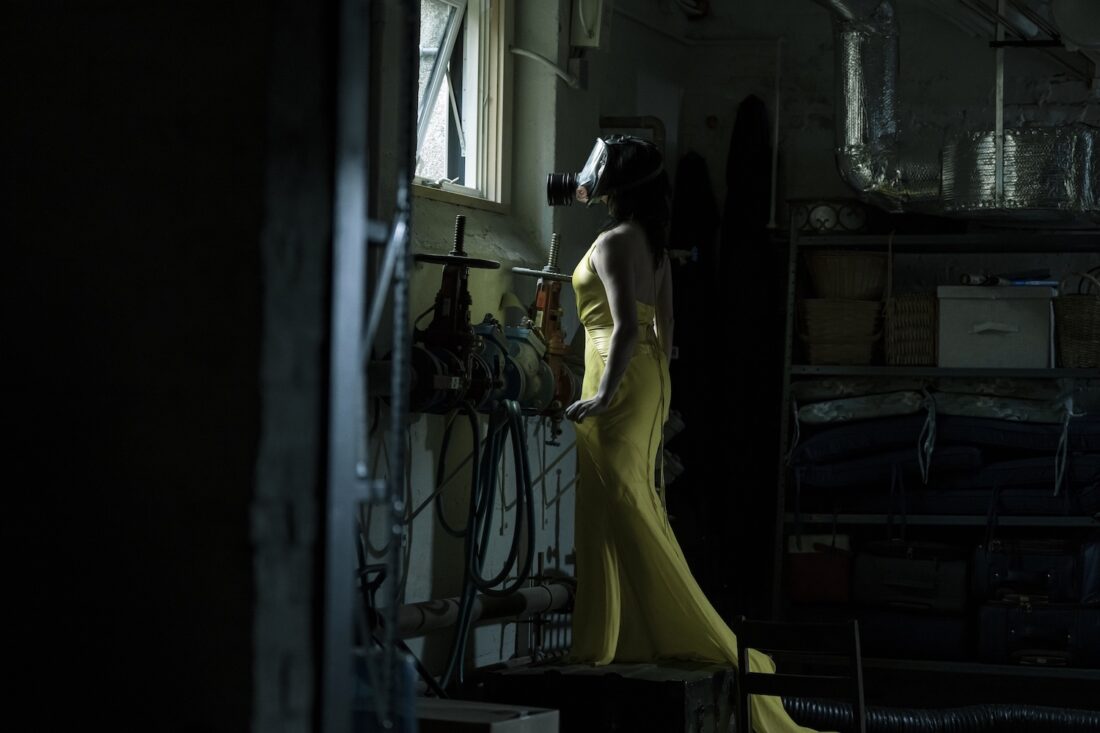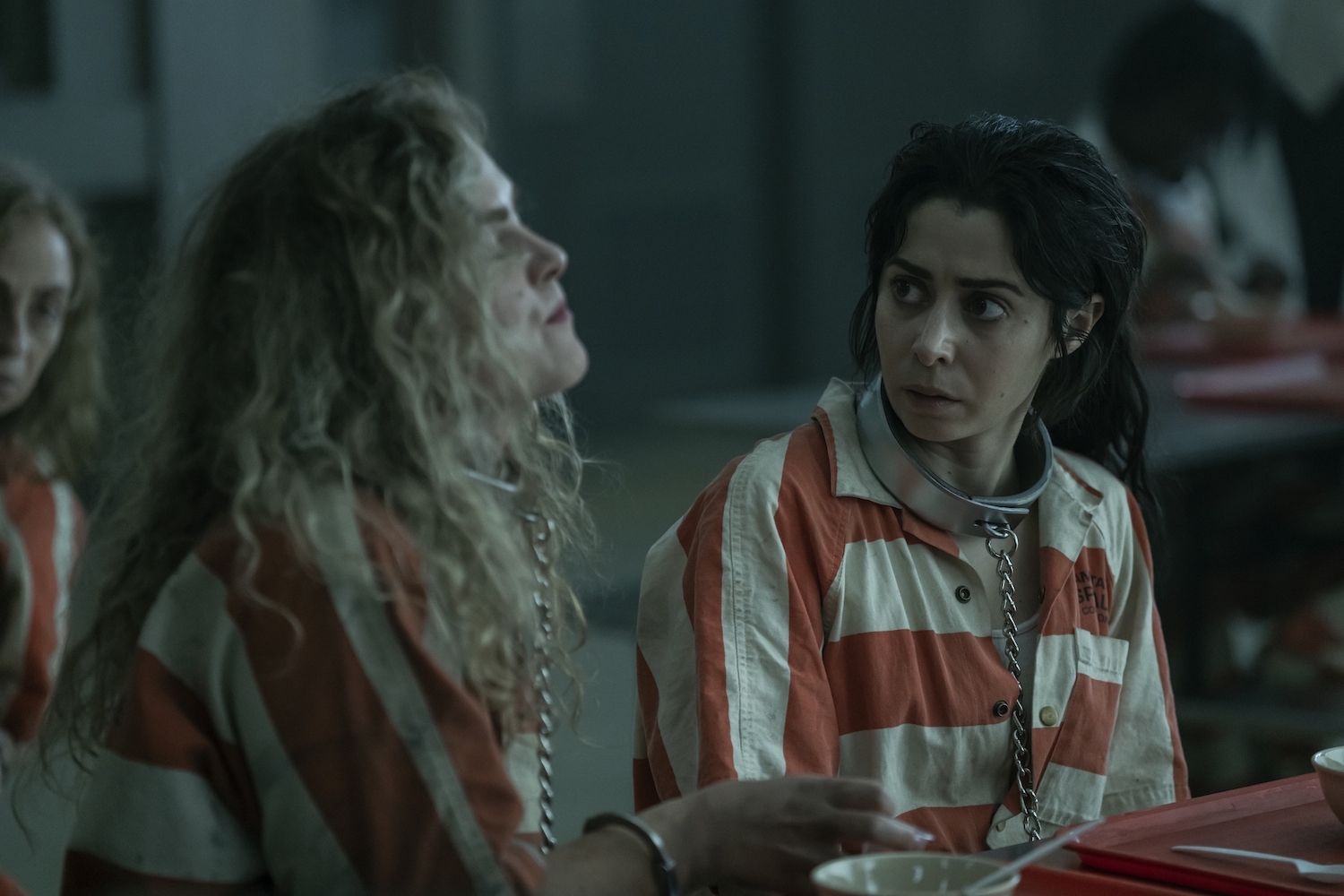After watching this week’s episode of The Penguin, I find it impossible to believe that someone on the production staff, whether it’s executive producer/showrunner Lauren LeFranc or someone underneath her, isn’t very familiar with Charlotte Perkins Gilman’s short story “The Yellow Wallpaper.”
Written in 1892, Gilman’s story is a scathing indictment of the treatment of women by the nascent psychiatric community of doctors, with women fobbed off into useless and/or harmful “treatments” to cure them of whatever ailments they were suffering from, whether real or imagined, and often an excuse to get rid of “problematic” women. The narrator of the story is confined to a room with yellow wallpaper. The tale is both a brilliant bit of social commentary and a magnificent horror story, as we get a first-person look at the narrator’s descent into madness, which is due, not to hysteria, as the male doctors have insisted, but her confinement in this one room that’s supposed to be for her own good.
The reason why I know that someone on the staff has to be familiar with the story (or, perhaps, one of the film adaptations of this nineteenth-century classic that has been done in the twenty-first century) is that Sofia Falcone’s story in the “Cent’Anni” episode of The Penguin is a pretty direct analogue to that of Gilman’s never-named narrator.
About two-thirds of the episode is given over to Sofia’s backstory. We start with the other half of the end of last week’s episode. Nadia Maroni makes it clear that she’s not going to put up with Penguin’s nonsense anymore. She also reveals to Sofia that Penguin, not Sal Maroni, killed her brother Alberto. Then Vic runs over one of Nadia’s thugs, Penguin shoots two more of them, and they get in the car and drive off. Somewhere in there, Sofia suffers a major head injury. She calls Dr. Rush to ask for help, then passes out…
…at which point we flash back a decade. Sofia is the good daughter to Carmine Falcone, the one who actually knows what she’s doing, as opposed to ne’er-do-well fuckup Alberto. We get the full story of how Sofia’s mother died: nine-year-old Sofia found her having apparently hanged herself. Carmine (played by Mark Strong due to John Turturro not being available to reprise his role from The Batman) tells her that he’s going to name her, rather than Alberto, his heir. Sofia is thrilled.
(The recasting is only partly successful. Strong has made a career out of playing bad guys—indeed, he has three other comic book villains on his resumé, Sinestro in Green Lantern, Dr. Sivana in Shazam!, and Frank D’Amico in Kick Ass—but one of the reasons why Turturro’s performance in The Batman worked so well is that he had a pleasant charm as the velvet glove over the iron fist of his menace. Strong is all iron fist; his drinking wine with Sofia when he makes her his heir should be more familial, but Strong’s sneer makes that not quite work as well as planned, thus diluting the impact of later scenes when the menace is more overt.)
And then Sofia makes her first mistake: she talks to a reporter. Summer Gleeson of the Gotham Gazette (a character who originated as a TV reporter in Batman: The Animated Series, played here by Nadine Malouf) approaches Sofia, and shows her evidence of several women who were killed by being hanged, just like her mother. It also looks like evidence was suppressed, both in the case of her mother and these women, who all worked in the secret “44 Below” club underneath the Iceberg Lounge (which we also saw in The Batman). We already know from the movie that Carmine sometimes slept with the women who worked there—one of them produced a child, Selina Kyle, a.k.a. Catwoman. And now it seems that someone has killed them but made it look like suicide. Gleeson thinks it might be Carmine.
Sofia’s driver, Oz Cobb—whom we see as someone friendly and helpful to Sofia, even though she mostly treats him like the help—is the one who takes her to a second meeting with Gleeson. At first Sofia is concerned, but then she tells the reporter to fuck off, particularly after Gleeson asks her to wear a wire into 44 Below.
Penguin tells Carmine about this, of course—how can he not? But Carmine’s reaction is devastating. It’s clear that Carmine is responsible for these women’s deaths—and also possibly for his wife’s death—and it’s equally clear that Sofia is starting to put it together. Carmine is no fool, and he knows his daughter is also no fool. So he preemptively takes her off the board, as it were, using his influence with his family, with the press, and with the police to have Sofia arrested for the murders of all the women, plus the latest victim: reporter Summer Gleeson.
Sofia is committed for psychiatric evaluation. Part of the evidence presented for that are affidavits from several family members, including Carla Viti. You might recall we saw an awkward conversation between Sofia and Carla last week, and this week the flashback shows the two of them thick as thieves prior to Sofia’s arrest. So Sofia is rather devastated to see that one of the affidavits claiming that Sofia has a (wholly fictional) history of mental illness is from Carla.

And so Sofia goes through what the narrator of Gilman’s short story goes through, only on a much bigger scale. She’s committed to Arkham State Hospital for six months to see if she’s competent to stand trial. We see Rush when he first met Sofia, the assistant to the head doctor, who treats Sofia like she’s already guilty, already diagnosed as being mentally unfit. Sofia’s next door to a blonde named Margaret Pye, who calls herself Magpie. (We also see her being given a red drug that we recognize from last week as Bliss; Magpie calls it “candy.”) Magpie is based on a Gotham City-based villain from the comics, and she’s also completely ’round the bend.
Sofia suffers through the half-year, which includes a rather appalling amount of electroshock therapy, expecting a trial at the end of it. But then we find out that the director of the hospital, no doubt at Carmine’s instruction, declared her unfit for trial and recommended she remain hospitalized.
And there she stayed for ten years. Throughout, we see the dehumanizing treatment, the assumptions of insanity based on no evidence except for the denial of same, which is both what a crazy person would say and what a sane person would say, so it’s rather poor evidence. The tiny cells, the abuse—at one point, a fellow inmate has somehow gotten out of her chains and assaulted Sofia; she later commits suicide with a fork—and the electroshock do their job a little too well. Driven to her breaking point by the denial of a trial, she beats Magpie to death in the mess hall and then declares to the doctors that she’s “fucking innocent.”
During all this, we see the wallpaper in her cell, and it’s yellow (matching the wallpaper in the room where she found her mother). She claws at it, just as Gilman’s narrator did, and it contributes to her downward spiral.
Then we cut back to the present. Rush apparently quit his job at Arkham in protest for how Sofia was treated, which is why he’s treating her privately now. We don’t see the exact circumstances of her release, though the fact that it happened after Carmine’s death is probably not a coincidence.

The main difference between Sofia and Gilman’s narrator is how it ends. Sofia not only is freed, she’s liberated. She isn’t the Hangman murderer, but everyone thinks she is, so she embraces it. She’s spent all her life being victimized at least in part because of her gender. (At one point before she’s arrested, and before Carmine initially makes her his heir, she says frankly to Penguin, “You have a dick, so at least you’re eligible for promotion.”) But now, she’s taking over in the only way she can. Wearing a bright yellow dress, she intrudes on a family dinner and tells everyone there how much she “appreciates” all the support she got from the family, who lied in affidavits and/or never visited or cared about her in the least after she was unjustly committed.
Then she wakes up Gia, Carla’s little daughter, and takes her out to the greenhouse for a midnight snack, and they then sleep there, just like she and Alberto did when they were kids. In the morning, she leaves Gia asleep and checks the house while wearing a gas mask: she’s gassed almost the entire house, and with the exception of Gia, safe in the greenhouse, and Johnny, whose room was spared, the entire Falcone family is dead. Why she kept Johnny alive (beyond Michael Kelly being in the opening credits) is not yet clear, but we’ve still got four episodes to go…
“Cent’Anni”—an Italian toast that means, “May you live a hundred yeas,” a toast Sofia gives to a room full of people she intends to murder that night—is a brilliant treatise on how it’s still, more than a century after “The Yellow Wallpaper,” incredibly easy to marginalize and relegate smart, capable women by deeming them hysterical. The difference here—because it’s fiction, and you can create your own ending—is that Sofia survives and now thrives.
As much as the title character, Sofia Falcone is a smart person who had the misfortune to be born with characteristics that make it easy for them to be dismissed. For Penguin, it’s his looks, deformities, and background. For Sofia, it’s that she was born with a uterus. It will be very interesting to see how the rest of this plays out, especially since they’re on opposite sides now, and the Maronis are still a wild card.
